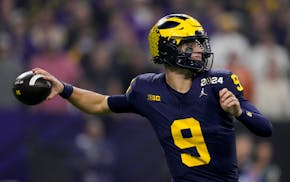Saturday, Y.E. Yang earned the honor of playing the final round of the PGA Championship alongside Tiger Woods.
By Sunday night, Y.E. will stand for "Yips, Etc."
Friday, Padraig Harrington admitted that playing with Woods wore him out. Saturday, Vijay Singh played in the final pairing with Tiger. At the beginning of the round, Tiger stood at minus-7, and Singh at minus-3. At the end of the round, Tiger stood at minus-8, and Singh at even par.
Woods no longer sprints away from his competition; he just stands on solid ground while they disappear in the quicksand of his making.
While Woods practiced crisis management, making just enough putts to take a two-stroke lead into the final round -- and he's 14-for-14 when leading a major after three rounds -- Singh demonstrated why he in particular and players of this generation in general have allowed Woods to dominate them.
Woods is the best clutch putter in golf history, especially when he holds the lead at a major.
Singh -- and Phil Mickelson, Ernie Els, Lee Westwood, Sergio Garcia and a half-dozen other wonderful ball-strikers of this era -- prove the adage that it is difficult to putt with both hands around your throat.
Saturday, Singh broke par on exactly one hole before making a birdie at 18 -- and that was his chip-in eagle on 7. He missed makeable birdie putts on 1, 3, 4, 5, 9, 15 and 17. He missed makeable par putts on 10, 13, 14 and 16.
If you were incapable of keeping score and judged them only by ball-striking and body language, you would have thought they played similar rounds. But Woods shot a workmanlike 71 to take a two-shot lead into the final round, and Singh shot a couldn't-have-been-any-worse 75 -- including a 40 on the back nine -- to eliminate himself from contention.
Woods hit nine fairways, 11 greens and 28 putts. Singh hit eight fairways and 12 greens. Singh also hit 32 putts, despite his chip-in.
Singh hit a beautiful drive and a crisp iron shot to give himself a birdie putt on the first hole, and missed it. Woods seems to recognize, and relish, such important moments. On 14, the short par-4, Woods hit his drive into the rough behind the hole. His chip ran past the flagstick to the fringe. He stood in front of a leaderboard bearing the news that Harrington had just made a birdie to reach 7 under, one behind Woods.
Woods faced a tricky chip, and decided to blade a wedge. He rolled it in, pumped his fist and yelled. Singh then missed his birdie putt ... before missing the comebacker for par.
Singh's powerful swing looks like an elegant dance move, but he spends most of his fidgety time during a round practicing his putting. During lulls, he putts to tee markers or to the bottom of his bag, or he practices swinging his putter -- with two hands, then either hand -- through the rough. It's as painful as watching Jesse Ventura try to speak English.
Every time Singh faced a 4-footer, you just hoped he could lag it close.
Did Singh putt poorly because that is his defining flaw, or because he was forced to play with Woods? Singh didn't stick around to answer such questions; Woods tried to be diplomatic.
"I think more than anything, it's just the amount of distractions inside the ropes," Woods said. "There's a lot of movement, a lot of cameras, a lot of media, a lot of people moving, and it can get you at times."
It shouldn't. Singh is 46. He's won three majors. He's played alongside Woods at countless events.
Saturday, though, Woods did the rope-a-dope and Singh putted like he was trying to get the ball to go through the windmill and into the clown's mouth.
It seems almost unfair that a major championship featuring majestic shots traversing a 7,600-yard course should be decided in the 5-foot radius of poana surrounding 18 flagsticks. But Woods doesn't seem to mind.
Jim Souhan can be heard Sundays from 10 a.m.-noon on AM-1500 KSTP. • jsouhan@startribune.com

Souhan: Wolves fans made Game 1 special. Now bring on Game 2.

Souhan: Should Vikings even consider McCarthy in NFL draft?

Souhan: NAW erases Suns' lead, Game 1 advantage with big performance

Souhan: This is KAT's chance to prove Flip Saunders was right


